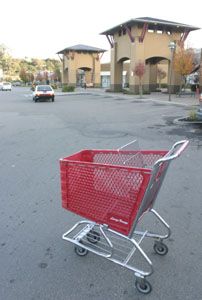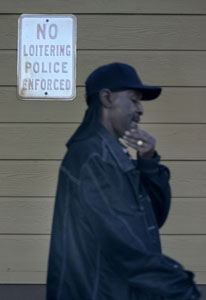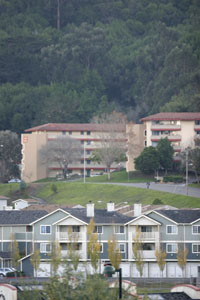![[Metroactive Features]](/gifs/feat468.gif)
[ Features Index | North Bay | Metroactive Home | Archives ]
Public/Private: The garrison-like public housing that distinguishes Marin City is balanced by an influx of condo units owned by those anxious to share Sausalito's zip code.
Rich Man's Ghetto
Snapshots of a life briefly led in Marin City
By Matt Pamatmat
There are some strange places on this earth, curious locales that have their own style and character, locations that seem the topographical equivalent of the platypus: thrown-together, mismatched, jarring, colorful, haunting. Between the covers of Camilo José Vergara's beautiful 1995 photo essay book The New American Ghetto are slides in black-and-white and color of such places, mostly bombed-out ruins of housing projects, redevelopment areas, urban atrocities and economic war zones. Vergara's book covers places that are indisputably ghetto: Newark; Cabrini Greens; South Central Los Angeles; Atlantic City; Gary, Indiana. The list goes on.
What many do not realize is that right in the well-educated, wealthy heart of Marin County--the per capita wealthiest, costliest county in the wealthiest, most powerful nation on earth--lies a place that may very well qualify as a bona fide ghetto.
Marin City, California. Isolated from its greater surroundings; predominantly poor and African American in a white, wealthy county; and plagued by drug abuse, poverty, broken homes and high incarceration rates, Marin City is also a small town proud of its history, tight-knit to the point of being suspicious of outsiders and one of three areas in Marin that counter stereotypes about the area as homogenous and well-off (the other two are the Latino-heavy Canal District of San Rafael and the merely middle-class reaches of south Novato).
"When I first came to Marin City," resident Melvin Atkins says, "it was like another world, like Disneyland or something. People were smoking joints and waving to the police as they drove by." Atkins is sometimes referred to, with both affection and sarcasm, as the "Mayor of Marin City." He is prominent in community affairs and conducts himself with the slow, stately manner of a philosopher king.
However, Marin City is an unincorporated area without such basic things as its own supermarket, post office or mayor. Much of the isolation comes from its denizens largely lacking their own cars and having to rely on bus service. There is also a more metaphysical, deeper isolation that is both mental and emotional--an isolation which runs along cultural, racial and financial lines.
Sausalito and Marin City may share a zip code, but they are worlds apart, Highway 101 dividing the two places like the proverbial railroad tracks.
Tied to Each Other
Although personal and institutional racism still exists, the story of Marin City is not a simple case of victims and abusers; the schism between the two worlds is mutual. Marin City residents often feel uncomfortable outside of their 1,600-person community, and outsiders are often frustrated by the suspicion and dysfunction that can characterize the community's workings. Many people simply don't know about Marin City, let alone its history, assets or challenges.
In many ways, Marin County has written off Marin City, but Marin City has also done the same with Marin County. Sadly, like oil and water, the two have agreed to disagree, to remain separate. Marin City youth don't see Sausalito as a place to work despite its physical proximity, using code words to describe the situation, calling it "too touristy." Conversely, many employers are reluctant to hire Marin City residents based on the stigma of the place and perceptions of community members as being low-skilled and hard to keep.
Although some of these attributes ring true, Marin City is just one of many places in the country that struggles with being isolated, ethnic and low-income. While no Hunter's Point (one person described Marin City as an "affluent ghetto"), it has characteristics of Newark, Detroit, Chicago, east Palo Alto and many places in the Deep South where communities face segregation, marginalization and gentrification.
A white man, I came to Marin City through a job posting on Craigslist.org, employed as a social worker for almost two years in what residents call "the Jungle." Like many people, I had no idea that Marin City existed in the first place. I was raised in liberal-minded white majority towns that spoke of a multicultural mindset but often lacked diversity. My mom was a staunch Democrat who preached racial harmony while sometimes making unknowing comments to the opposite effect. My basketball coach warned us when we played against teams from grittier, more ethnically diverse towns. Friends of mine made blanket statements about the danger of going into Oakland. I occasionally heard the n-word in situations that were awkward and wince-inducing. I began to notice that there existed a generally tolerant idealism that, as T. S. Eliot wrote, contained a great shadow between it and reality.
This unincorporated stretch represents the interesting twists and turns a simple freeway exit can present. Heading one way leads to a wealthy, white, artsy bayside community famous for its view of San Francisco and its well-to-do tourists walking pleasant sidewalks--a cookie is named for the town. Heading the other way brings you to Marin City.
Three Men
Melvin Atkins drives around in a beat-up white Japanese car, attending community functions and working part-time at one of the community's many battered social service agencies. He is partially balding, but his remaining hair, gray on the sides, is grown out in a triumphant afro. He speaks slowly and philosophically, expressing great care for the community and noting that many of the truths differ from perceptions about this unique town. "We have a lot of talented people here," he says, "and despite our problems, there are a lot of hard-working families trying to get by and pursue life, liberty and happiness."
Marin City is often identified with the ghost of its flourishing former local flea market, once conducted on weekends where a struggling, half-vacant shopping center erected in the mid-1990s now stands. Many people miss the flea market, but Marin City continues to hold events for residents and the greater community, with concerts, talent shows, job fairs and a Juneteenth festival celebrating black emancipation from slavery.
Desmond Jupiter, a fellow social worker, shows me around one day. Jupiter is a tall, thin, friendly man who looks much younger than his 50 years. He is originally from Louisiana and still has a Southern gentlemanly charm about him. He recently moved.
"Marin City is nice, man" he says, "you know, there ain't no cars on fire or people shootin' at each other. The public housing is nice. But I work in the community helping people, and it became a 24-hour-a-day thing, so I had to get out. It was hard both living and working here."
Jupiter is in recovery from substance abuse and formerly lived in the tall public housing apartments at the base of the Marin headlands. He laughs at some of the things he's experienced but knows firsthand the dangers of addiction and destitution that tempt many residents.
"I come out my house one day, right?" he explains, "and on my patio is a bunch of people drinkin' wine. I look at my watch and it's about 6:30am!" He smiles and shakes his head gently.
Derek "Dudley" Morgan is a former convict and drug dealer who has turned his life around and now works helping men in the community become more responsible fathers. Derek gets his nickname from acting like the Canadian Mountie cartoon character Dudley Do-Right, passionately working to help his clients realize the errors of their ways and to take ownership of their lives and families. He dresses in stylish hip-hop attire, has gold teeth and speaks honestly and passionately about the community.
I run into him one day as he is driving through the community. He is generous and forthright, knowing firsthand the difficulties many residents face, and is committed to helping improve the community. He leans out of his car, smiling wide, holding out a bag of beef sticks. "You want a beef stick? Come on now, I know you do! You in the ghetto now, baby!" he booms good-naturedly. I accept, chewing thoughtfully. Laughing like Public Enemy's Flavor Flav, he drives away.
Paradise Lost
Marin City's history is interesting if dark and enigmatic. The general area of Sausalito was a shipbuilding community in the 1940s that produced boats for the war effort. Black port workers left the hostile, segregated, opportunityless Jim Crow South and migrated to Marin City, cohabitating peacefully with white neighbors in a community of colleagues where everyone was provided housing. It was a community that generally got along, neighbors watching out for each other. However, after the war, as jobs disappeared, "white flight" followed, and the remaining folks were left jobless and unskilled outside of shipbuilding.
Robert Kennedy's innovative passage of community development corporations, coupled with the social programs of the 1960s and Lyndon Johnson's "war on poverty," brought dollars and services into Marin City, but the place remained largely an anomaly, not able to match the prosperity that its surrounding environs experienced over the years. Through the years and amid increased Marin County diversity, Marin City itself has remained proudly and resoundingly African American.
With some notoriety, the community is infamous for its 200 block, where many public housing residents can be found loitering and chatting throughout the day. The area is known for drug transactions, gambling and open drinking, and any nonblack is regarded with suspicion, especially whites who are viewed as potential police officers. A segment of the 200 block known as the "Black Hole" is where youth, many of whom are high school dropouts headed for bleak futures, congregate. Graffiti abounds, and residents, though many are from hard-working, upstanding families, spend jobless days just hanging out or rolling the dice.
Herman (he goes only by this terse first name) lives in the heart of both the 200 block and the Black Hole, and is known for his barbecue skills and the sodas he sells. This practice dates back to times when the community had no supermarket (the closest thing currently is a Long's Drugs; the Safeway is two miles away) and residents had to become entrepreneurial in order to make ends meet. Herman cooks chicken and ribs on a half-barrel grill whose smoke drifts upward over the austere scene of the block. For $7 you can get his combo plate, containing grilled meats plus two sides (spaghetti with hot dogs and salad, or whatever Herman has on hand) and two pieces of white bread in a plastic bag.
Deal of the Year
The Gateway Shopping Center, also known as the Marin City Shopping Center, is something of a ghost town. The Coffeesmith, an independent coffeehouse which was once very much the heart of the center, has left. Shortly after, the corner barbershop vacated. The remaining businesses provide questionable products to an at-risk community: Cigarettes Cheaper and Burger King. Long's, although it is a pivotal store in the center, has rigged its liquor section with highly visible security devices.
Lacking substantial recreation programs to occupy them, Marin City youth, in baggy apparel, cornrows and with a dark look in their eyes, wander the desolate center as wealthy Marinites search for bargains at Best Buy. One day, I noticed an angry young black man shoving shopping carts around while an older white woman meticulously cleaned a spot off her Mercedes in the parking lot. The juxtaposition was, needless to say, striking.
Nonetheless, the shopping center was awarded the "Best Real Estate Deal" of 2003 by the San Francisco Business Times, due to a deal in which ownership of the strip mall was placed in the community's hands, with future profits aimed at helping fund community improvement services.
Three Different Men
One day at work, a co-worker's client came in with a bloody head, exasperated and semicoherent. This client visited my co-worker frequently, often without an appointment, clutching a handful of dirty job applications and expressing continued frustration in his search for a job, a place to live and some stability in his life. His mother ran a daycare center during the day and needed him gone. He worked with a local environmental group but was released for his aberrant behavior. He was known as an arsonist. Sometimes I saw him outside of my narrow window talking to a tree. I often wondered if he would be like this no matter where he was, or if this was what the ghetto did to you, how it warped your mind.
Through this same window, I have watched a local resident with mental problems and a flair for transgender makeup, local politics and gossip choreograph dance moves while watching himself in the reflection of a broken windowpane. A small boombox played instrumental dance music as he furiously worked out his steps. I thought of a blaxploitation version of the horror flick Silence of the Lambs. Once, I left my office, headed to the withered shopping center for a soda, and he incorporated my movement into his imagined production. "OK, Matt, six and seven and eight and nine and . . ." I smiled sheepishly and kept walking.
On another day, on my way to a meeting, I watched a black elementary-age youth beat up a playground with a golf club, the clanging metal echoing under a blue sky, rising sun and silent fog rolling over the Marin Headlands. The playground had been marked with black spray paint and a single, emphatic marking--"FUCK"--a word that seemed to convey many aspects of the place, an all-encompassing word expressing desperation, apathy, hostility, nihilism.
Social Ecologies
As a social worker, I was involved with trying to fix some of Marin City's problems, and with providing the up-and-coming citizens with an expanded view of the world. Because of this, my viewpoint was undoubtedly skewed toward what's wrong in Marin City, which is overall concentrated in the public housing area and the 200 block. The verdict is still out on where the town itself begins and ends--are the largely white condo owners on the hill part of Marin City? How will the community define itself in the inevitable future of increased diversity and mixed ethnicities? And, perhaps most importantly, will real change occur in Marin City and surrounding Marin County--will the poor, black and forgotten of the area gain equal footing in the game of life? Will they gain access to the rich resources and prosperity of the area?
One day, Dudley Morgan told me that he didn't understand how foundations and philanthropists could fund programs and projects to save or restore wildlife in Marin County while programs for human beings in Marin City were not being approved or were being defunded.
It seems to be an interesting character trait of Marin County that it is fiercely environmental-minded, while Marin City (as well as the Canal and south Novato) languish in substandard existence. What is the unspoken message? Are a lack of billboards more important to its largely white, educated and wealthy voters than its pockets of diversity and struggling families? Or is the situation so complex that, although all could see the dilemmas, few had any answers?
Goodbye
After working about a year in Marin City, my initial enthusiasm, idealism and spirit had deflated. Although I didn't realize it at the time, I was beginning to feel the effects of what is called in the human service industry "compassion fatigue." Workers who deal with people and their problems on a constant basis sometimes become overwhelmed with the magnitude of the problems and the lack of lasting solutions.
Rent in Marin City's public-housing units goes up the more an individual earns, for example, sometimes causing residents to remain low-income or make quick money in the drug trade in order to hang on to their homes. Agencies and key players sometimes became "poverty pimps"--more concerned with their own survival than the people they were helping. Racism, a welfare mentality, crime, substance abuse, cultural barriers, lack of power and undereducation all swirl together in a dangerous mixture that keeps communities down. I was feeling it; at least I could leave.
And so I did. I did not carry away any final analysis, conclusion or solution to Marin City. As a former co-worker said: "Marin City will always be in my heart."
[ North Bay | Metroactive Central | Archives ]
Copyright © Metro Publishing Inc. Maintained by Boulevards New Media.
![]()

Photographs by Rory McNamara
Superiority? Inferiority? Why not the quite simple attempt to touch the other, to feel the other, to explain the other to myself?
--Frantz Fanon, Black Skin, White Masks

Police Enforced: Where else in the entire North Bay have you seen such a sign?

Sentinels of Commerce: The Gateway Shopping Center serves Marin County bargain hunters but has little practical use for Marin City residents. The closest grocery store is two miles away.
From the December 1-7, 2004 issue of the North Bay Bohemian.